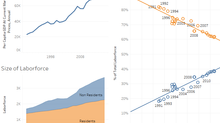Why Facts Alone Fail: The Missing Ingredient in Your Data Presentation

The Problem with Facts Alone
In today’s data-driven world, organizations are drowning in numbers. Dashboards overflow with metrics, reports pile up unread, and yet decisions often stall—or worse, go awry. Why? Because facts alone don’t persuade. Raw data might tell you what is happening, but it rarely answers the more critical questions: Why should I care? and What do I do about it?
The Power of Storytelling
This gap between data and action is where storytelling comes in. Humans aren’t wired to process spreadsheets emotionally. We’re wired for stories. Stories engage not just our logical minds but also our emotions—the part that drives decision-making. As highlighted in our training materials, good data storytelling leverages both emotional and rational appeal, creating narratives that resonate deeply with audiences.
A Framework for Building Your Data Story
But how do you turn cold, hard data into a compelling story? One powerful framework we teach is the PAST, PRESENT & FUTURE model . This approach helps structure your narrative by addressing three key phases:
Past: What happened? What led us here?
Present: Where are we now? Why does this matter?
Future: What could happen if we act—or don’t?

For example, imagine presenting declining sales figures. Instead of simply showing a downward trend, you frame it as a problem with real consequences: “If this continues, we risk losing $X million within the next year.” Suddenly, the data isn’t just numbers—it’s a call to action.
Crafting Persuasive Narratives
However, crafting such stories requires skill. You need to know how to prioritize insights, select the right visuals, and deliver your message with clarity and impact. These are exactly the skills we’ll cover in our upcoming Data Storytelling Workshop.
One common pitfall many professionals encounter is focusing too much on the data itself rather than its implications. For instance, using overly complex charts or overwhelming audiences with unnecessary details can dilute your message. During the workshop, we’ll dive deeper into techniques for simplifying your data without losing its essence, ensuring your audience stays engaged from start to finish.
Bridging the Gap Between Data and Action
Ultimately, the goal of data storytelling is to bridge the gap between analysis and action. By combining data with narrative, you create a powerful tool for driving change. Whether you’re trying to secure buy-in for a new initiative, justify budget allocations, or inspire your team, mastering the art of data storytelling can make all the difference.
Take the Next Step
Ready to transform your data into persuasive stories that drive change? Register now to secure your spot in our workshop and unlock the full potential of your data!


























Comentários